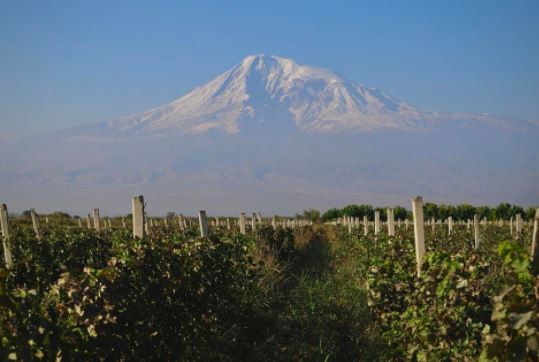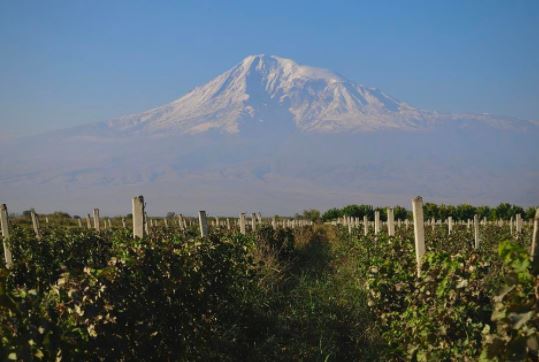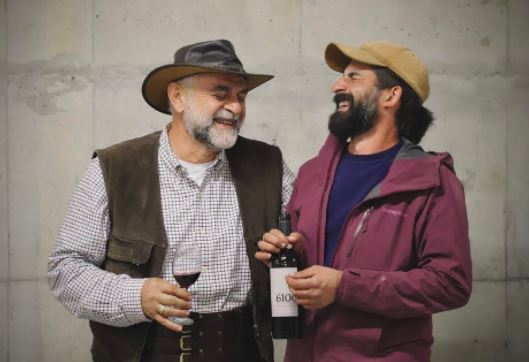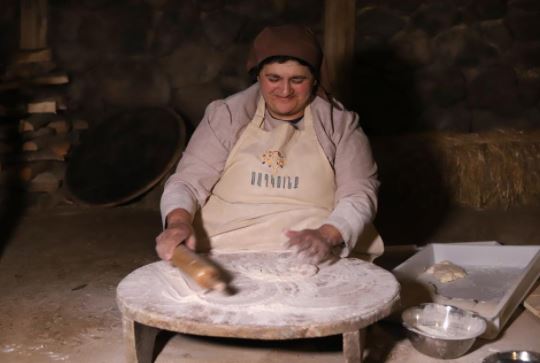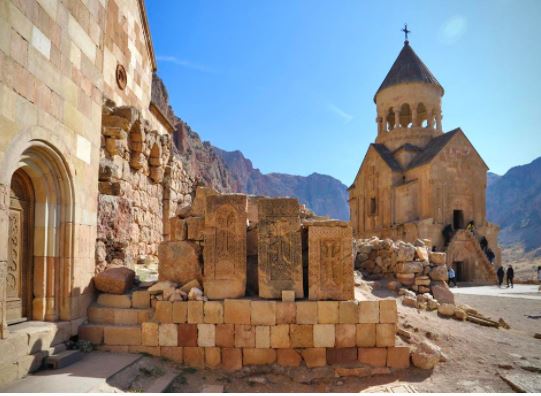Here’s Why Armenia Is Emerging As The Next Food And Wine Travel Destination
Ann Abel, Forbes
“My life is different because of Armenia,” said Veronica Joy Rogov as she welcomed guests to the final dinner of an audacious project at an audacious restaurant in Armenia. We had flown from all over the world to this small mountain village an hour outside the capital, Yerevan, to discover something new, to let ourselves be surprised and perhaps to be part of the beginning of something wonderful.
Rogov, a hospitality and wine consultant for Michelin-star restaurants, had flown in from the U.S., along with chef Mads Refslund—a cofounder of the original, wildly influential Noma in Copenhagen—and a team of other restaurant geniuses. They immersed themselves in all things Armenian for a month, learning traditional recipes and meeting purveyors, and then worked with the staff at the new Tsaghkunk Restaurant to create and serve a series of unforgettable dinners.
Read also
Their mission—along with providing a whole lot of pleasure to diners who made the journey—was to help one of the oldest countries in the world develop its future contemporary culinary language. That meant a thorough exploration of this unique but forgotten (or misunderstood) land at the crossroads between Europe, Asia and the Middle East, and then a deep sharing of knowledge.
The project was a collaboration between Hrachya Aghajanyan, the former Armenian ambassador to Denmark and Norway, and his friend Kristian Brask Thomsen of Bon Vivant Communications, whom he used to introduce as the Ambassador of Pleasure because of his work organizing dining extravaganzas that connect people from around the world. (Eating together being the most enjoyable kind of diplomacy.) That’s what they’re doing here, not just with the Refslund collaboration but with the restaurant (whose resident chef, Susanna Guckasyan, and team were fantastic even before they gained inspiration and know-how from the foreigners), and with a spotlight trained on Armenian food and culture in general.
They rightly believe Armenia deserves some of the attention that its neighbor Georgia gets as a destination for food and wine. Culinary tourism has a way of attracting high-value, low-impact travelers, who redirect their wealth into local economies.
But as Rogov said, Armenia makes an impact on anyone who visits. (It was country number 100 for me, and it still managed to leave me struggling to find comparisons.) There is, as she also said, a certain heaviness to it, thanks to sheer weight of its millennia of history.
Some of that history is quite awful (and the reason that are more than twice as many Armenians in the diaspora than in the country itself). I won’t dwell on it. Because aside from talking about it with our hosts and guides, I didn’t think about it. I especially didn’t feel it, particularly in Yerevan, with its European-ish vibe and lively nightlife.
First there’s the kindness and generosity. I felt that at Yerevan’s sprawling GUM Food Market, where vendors were impossibly generous with free samples of dried fruits, candied almonds, pickled cucumbers and (entire heads of) garlic, and salty underground-fermented cheese. (I mean, we already had our hands full of snacks.)
And I felt it at the boutique Van Ardi Estate winery, where owner Varuzhan Mouradian kept pouring refills of whichever wine we liked best as the sun set over the ancient winemaking region of Aragatsotn. And at every single meal, where the hospitality is so abundant that food ends up being placed (on stands) on top of other food, and everything is shared by a big group of people gathered around the table. As Armenian minister of economy Vahan Kerobyan said, “Love to guests is in our genes.”
Then there’s the smiles and the joy. I felt that at Trinity Canyon Vineyards in the southern highlands (near the world’s oldest wine producing site, which dates back some 6,100 years), where executive director Hovakim Saghatelyan broke into an easy laugh as he clinked his glass with his visitors and later played for us a song he wrote “when I fell in love the 56th time.” And I felt it at Lavash restaurant in Yerevan, where an exuberant server coaxed me out of my chair to dance as he presented roasted pumpkins stuffed with rice, dried fruit and sometimes lamb (delicious) to the table.
And then there’s the intellectualism. I felt that in so many of my conversations. Chess is a national sport. Gregory the Illuminator is known for establishing Christianity in Armenia, in the year 301, making it the first Christian country in the world. But “illumination” in its more modern meaning continues to be a value. Displayed in the museum complex of the Matenadaran are old printed books, precious bindings, manuscripts, colorful book illustrations and miniatures from the organization’s collection of 23,000 manuscripts. It says a lot about the Armenians that during the genocide perpetrated against them by the Ottoman Empire in the early 20th century, they chose to protect their beautiful books.
Now, the new generation is trying to position education, the illumination of knowledge and technology as exports. (The app Piscart was an Armenian unicorn.) The United World College in the northern town of Dilijan attracts students from all over the globe—and sends them home with some uniquely Armenian enlightenment.
Dilijan is also home to a new endeavor that combines knowledge and understanding with food. The Armenian Food Lab is a project of art historian Ani Harutyunyan. In it she explores the ingredients, traditional culinary techniques and nutrition culture in Armenia. She also welcomes guests with plenty of consumable (and visual) aids, on another table laden with fresh and foraged products, from bitter herbs to black walnuts.
Like any cuisine, Armenian food is varied, but a few patterns emerged. There are lots of fresh herbs and pomegranate seeds, rather than spices. Lamb, eggplant, yogurt and various fresh and salty cheeses are recurrent. There are always copious amounts of lavash, the flash-baked flatbread that’s such an integral part of Armenian culture that it’s on UNESCO’s Intangible Cultural Heritage list. There’s often aveluk, an indigenous wild sorrel, which is delicious. Sometimes there’s lake trout.
Refreshingly, there are no tourist restaurants (too few tourists). Nor is there Starbucks or McDonald’s. Rather, there are places like Imtoon, also in Dilijan, a stylish mountain restaurant and guesthouse, and like Vostan, a heritage restaurant with honest cooking and traditional wooden interiors, in Yerevan.
There is also the strangest cooking technique I’ve seen anywhere in the world. It appeared on my itinerary as “satellite trout.” The fish is placed in a glass baking dish with apricots and fresh walnuts, and then the whole thing is suspended above an enormous mirrored structure that looks like a satellite dish. The mirrors reflect the sun’s rays into the baking dish, where their heat evenly cooks the fish.
It sounds like a gimmick, but it’s the opposite. Engineers donated their time to design the structures, which were set in the garden at Machanents House, a tourism and art social enterprise in the holy capital of Ejmiatsin. It’s an experiment in sustainable cooking, as it doesn’t require electricity, any other fuel or cooking oil. There are hopes of making it scalable, building more and set them up in remote mountain villages. The idea left me a bit in awe.
That wasn’t the only time. I felt awe at the history of the Orthodox (called Apostolic) churches that have stood for centuries upon centuries, from the 9th-century monastery complex of Sevanavank in the north to the 13th-century Noravank (“new church”) in the south. The most moving of all is Etchmiadzin, outside Yerevan, built in 303AD and often considered the Vatican of the Armenian Apostolic Church. (The world’s most famous Armenian, Kim Kardashian West, apparently felt that same awe.)
There was plenty of awe at the natural landscapes too. Some 80% of the country is mountainous. There is beauty everywhere, especially the high-altitude Lake Sevan and the rugged and wild terrain of the south (including stretches of the actual Silk Road). Indiana Jones and James Bond comparisons flew as we rode over a long, bumpy road to the mountains of the Syunik Province, high up with hostile land on both sides.
There, the Wings of Tatev, the longest double-track cable car in the world, takes visitors on a stunning, five-kilometer ride over mountainous terrain to the Tatev Monastery, whose restoration is in progress. It’s another project to develop the right kind of tourism and create new jobs in the area.
Because Brask Thomsen organized the trip, the cable car was stopped midway across, some 1,000 feet above a deep gorge, sparkling wine was popped, and sweet snacks were prepared by an Armenian celebrity chef. (It’s a big car.) And after the return, a few us of boarded an Airbus H130 flown by Armenian Helicopters for a dazzling ride back to Yerevan as the sun was setting. Along with 100 countries, I’ve also been in more than my share of helicopters, and that one was something else.
Granted, those experiences aren’t available to everyone. Nor were the dinners with Refslund, which are over now anyway. But they show the level of investment that some dreamers are making in Armenia—and that the country is ready for the attention.




















































